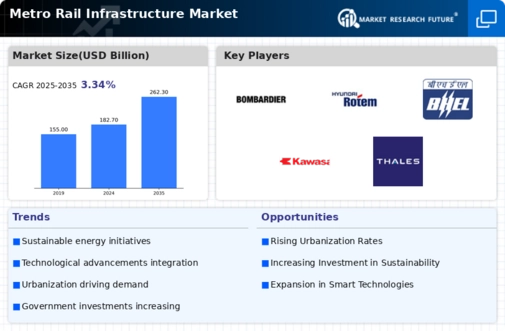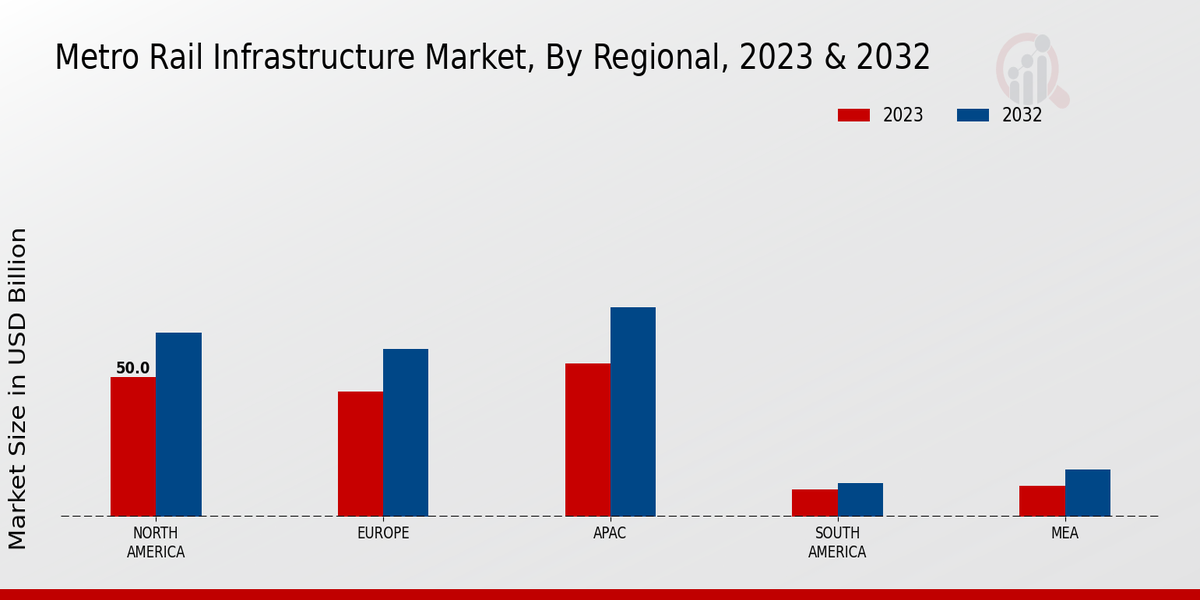Urbanization Trends
The rapid urbanization across the globe significantly drives the Global Metro Rail Infrastructure Market Industry. As cities expand, the demand for efficient public transport systems increases. In 2024, the market is projected to reach 182.7 USD Billion, reflecting the urgent need for sustainable urban mobility solutions. Metro rail systems provide a viable alternative to road transport, reducing congestion and pollution. For instance, cities like Tokyo and New York have successfully integrated metro systems to accommodate growing populations. This trend is expected to continue, with the market anticipated to grow at a CAGR of 3.34% from 2025 to 2035, reaching 262.3 USD Billion by 2035.
Environmental Concerns
Environmental concerns are increasingly influencing the Global Metro Rail Infrastructure Market Industry. With growing awareness of climate change and air pollution, there is a strong push for sustainable transportation solutions. Metro rail systems are recognized for their lower carbon footprint compared to road transport. Cities are investing in metro projects to promote eco-friendly commuting options, which aligns with global sustainability goals. For example, European cities are prioritizing metro expansions as part of their climate action plans. This shift towards greener transport solutions is likely to drive market growth, as more governments recognize the importance of sustainable infrastructure.
Market Growth Projections
The Global Metro Rail Infrastructure Market Industry is poised for substantial growth, with projections indicating a market size of 182.7 USD Billion in 2024 and an expected increase to 262.3 USD Billion by 2035. The compound annual growth rate (CAGR) is estimated at 3.34% from 2025 to 2035, reflecting the increasing demand for efficient urban transportation solutions. This growth trajectory suggests a robust investment landscape, driven by urbanization, government initiatives, and technological advancements. The market's expansion will likely be influenced by various factors, including economic conditions and environmental considerations, shaping the future of metro rail infrastructure worldwide.
Technological Advancements
Technological advancements are pivotal in transforming the Global Metro Rail Infrastructure Market Industry. Innovations such as automated train operations, advanced signaling systems, and energy-efficient trains enhance operational efficiency and safety. For instance, cities like Singapore and Dubai are implementing cutting-edge technologies to optimize their metro systems. These advancements not only improve service reliability but also attract more passengers, thereby increasing ridership. As technology continues to evolve, it is expected to play a significant role in the expansion of metro rail networks globally, potentially leading to increased investments and market growth.
Economic Growth and Investment
Economic growth and investment trends significantly impact the Global Metro Rail Infrastructure Market Industry. As economies expand, there is a corresponding increase in demand for efficient public transport systems. Countries experiencing rapid economic development, such as those in Southeast Asia, are investing heavily in metro rail infrastructure to support urban mobility. This investment not only facilitates economic activities but also enhances the quality of life for residents. The anticipated growth of the market, projected to reach 262.3 USD Billion by 2035, underscores the importance of economic factors in driving metro rail projects globally.
Government Initiatives and Investments
Government initiatives play a crucial role in shaping the Global Metro Rail Infrastructure Market Industry. Many countries are prioritizing investments in metro rail systems to enhance urban mobility and reduce carbon emissions. For example, the Indian government has launched several metro projects in major cities, aiming to improve public transport accessibility. Such initiatives often involve substantial funding and public-private partnerships, which can accelerate project completion. The increasing focus on sustainable transport solutions indicates a long-term commitment to expanding metro networks, thereby contributing to the overall market growth. This proactive approach is likely to bolster the market's expansion in the coming years.

















Leave a Comment